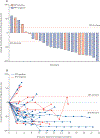Pembrolizumab plus cetuximab in patients with recurrent or metastatic head and neck squamous cell carcinoma: an open-label, multi-arm, non-randomised, multicentre, phase 2 trial
- PMID: 33989559
- PMCID: PMC12140401
- DOI: 10.1016/S1470-2045(21)00136-4
Pembrolizumab plus cetuximab in patients with recurrent or metastatic head and neck squamous cell carcinoma: an open-label, multi-arm, non-randomised, multicentre, phase 2 trial
Abstract
Background: Pembrolizumab (PD-1 inhibitor) and cetuximab (EGFR inhibitor) are active as single agents and in combination with cytotoxic chemotherapy for recurrent or metastatic head and neck squamous cell carcinoma (HNSCC). Given each drug's single agent activity and unique mechanism of action, we aimed to evaluate the anti-tumour activity of PD-1 blockade with EGFR inhibition in recurrent or metastatic HNSCC.
Methods: This study is an open-label, non-randomised, multi-arm, phase 2 trial done at four academic centres in the USA. Participants were required to have platinum-resistant or platinum-ineligible, recurrent or metastatic HNSCC, be at least 18 years old, have an Eastern Cooperative Oncology Group performance status 0-1, have measurable disease per Response Evaluation Criteria in Solid Tumors (RECIST) version 1.1, and to have received no previous immunotherapy or EGFR inhibition. All participants received pembrolizumab 200 mg intravenously every 3 weeks, combined with an initial loading dose of cetuximab 400 mg/m2 intravenously followed by 250 mg/m2 intravenously weekly (21 day cycle). The primary endpoint was overall response rate defined as the proportion of participants with a partial or complete responses (per RECIST version 1.1) by 6 months in the intention-to-treat population. The safety population included all participants who received at least one dose of pembrolizumab. Herein, the final analysis of cohort 1 (no previous PD-1, PD-L1, or EGFR inhibition for recurrent or metastatic HNSCC) is reported. Three additional cohorts (two for participants with a previous response to immunotherapy followed by relapse or progression, with or without previous cetuximab exposure, and one for cutaneous HNSCC) will be reported separately once fully accrued. This study is registered with ClinicalTrials.gov, NCT03082534, and remains open as the three additional cohorts are actively accruing participants.
Findings: Between March 22, 2017, and July 16, 2019, 33 participants were enrolled to cohort 1. All 33 participants received at least one dose of pembrolizumab. Median follow-up duration was 7·3 months (IQR 3·9-10·9). By 6 months, the overall response rate was 45% (95% CI 28-62), with 15 of 33 participants achieving a partial response. The most common grade 3-4 treatment-related adverse event was oral mucositis (three [9%] of 33 participants), and serious treatment-related adverse events occurred in five (15%) participants. No treatment-related deaths occurred.
Interpretation: Pembrolizumab combined with cetuximab shows promising clinical activity for recurrent or metastatic HNSCC, and merits further investigation.
Funding: Merck Sharp & Dohme.
Copyright © 2021 Elsevier Ltd. All rights reserved.
Conflict of interest statement
Declaration of interests AGS reports institutional research funding from Merck for the study presented in the article. FPW reports honoraria outside of the submitted work from Merck and Eli Lilly for advisory boards, and support for attending meetings or travel, or both, from Merck outside the submitted work. DJLW reports institutional research funding from Merck, Sharp & Dohme and Eli Lilly, outside the submitted work. DA reports institutional research funding from Merck for the study presented in the Article; institutional grants or contracts outside the submitted work from Aduro, Celgene (Bristol Myers Squibb), Novartis, AstraZeneca, Atara Biio, Blueprint Medicine, Celldex, Kura, Exelixis, Innate, Sensei, Matrix Biomed, Hookipa, CoFactor, Cue Biopharma, Medimmune, Shanghai Denovo, Eli Lilly, and Pfizer; and participation on a data safety monitoring board or advisory board outside the submitted work for Merck, Cue Biopharma, Pfizer, Celgene (Bristol Myers Squibb), and Eli Lilly. PS reports grants or contracts outside the submitted work from Pfizer and Ascentage Pharma, applications for provisional patents for companion diagnostics outside the submitted work, and participation on a data safety monitoring board or advisory board outside the submitted work for Prelude Therapeutics and Regeneron. PO reports honoraria for speaker bureaus in which he provided lectures from Merck and Bristol Myers Squibb for speaker bureaus outside the submitted work. KG reports institutional research funding from Pfizer and Pharmacyclics outside the submitted work, and personal consulting fees (advisory boards) from AstraZeneca, Takeda, Rakuten, and Regeneron outside the submitted work. EEWC reports personal consulting fees from Merck and Merck Sharp & Dohme outside the submitted work. All other authors declare no competing interests.
Figures




References
-
- Sacco AG, Cohen EE. Current treatment options for recurrent or metastatic head and neck squamous cell carcinoma. J Clin Oncol 2015; 33: 3305–13. - PubMed
-
- Vermorken JB, Trigo J, Hitt R, et al. Open-label, uncontrolled, multicenter phase II study to evaluate the efficacy and toxicity of cetuximab as a single agent in patients with recurrent and/or metastatic squamous cell carcinoma of the head and neck who failed to respond to platinum-based therapy. J Clin Oncol 2007; 25: 2171–77. - PubMed
-
- Cohen EEW, Soulieres D, Le Tourneau C, et al. Pembrolizumab versus methotrexate, docetaxel or cetuximab for recurrent or metastatic head-and-neck squamous cell carcinoma (KEYNOTE-040): a randomised, open-label, phase 3 study. Lancet 2019: 393: 12–18. - PubMed
-
- Seiwert TY, Burtness B, Mehra R, et al. Safety and clinical activity of pembrolizumab for treatment of recurrent or metastatic squamous cell carcinoma of the head and neck (KEYNOTE-012): an open-label, multicenter, phase 1b trial. Lancet Oncol 2016; 17: 956–65. - PubMed
Publication types
MeSH terms
Substances
Associated data
Grants and funding
LinkOut - more resources
Full Text Sources
Other Literature Sources
Medical
Research Materials
Miscellaneous

